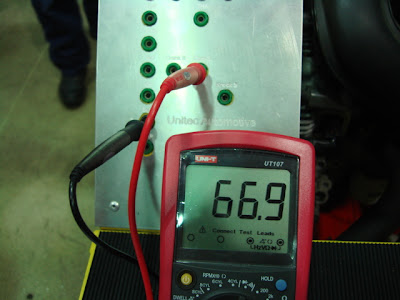ABS components:
1. brake rotor 2. wheel speed sensor 3. wheel speed sensor rotor 4. ABS module 5. brake master cylinder 6. caliper 7. booster
Wiring diagram practice:
The colour code of wires:
Using the wiring diagram in the workshop manuals identify the wheel speed sensors and list their wire colours for each sensor:
Front right: Black(+) White(-)
Front left: Red(+) Green(-)
Rear right: Yellow(+) Brown(-)
Rear left: Blue(+) Pink(-)
In the ABS wheel speed sensor, the braded wire is grounded wire, it is used to stop the EMF to effect the signal in the sensor wire.
The fuses in the ABS circuit:
1. FL main 3.0w 2. ASB 50A 3. Gauge 10A 4. Dome 20A 5. Stop 15A 6. ECU-1G 15A
The earth wire colours and pin numbers of ABS control unit and ABS motor:
ABS control: Pin 10 and 7( White-Black )
ABS motor: Pin 1( White-Black )
On the wiring diagram for the ABS actuator, identify which solenoids control which wheel cylinder.
Front Right Wheel: Pin 2(Red-White), Pin 6(Red-Green)
Front Left Wheel: Pin 3(Blue-Red), Pin 7(Blue-White)
Rear Right Wheel: Pin 4(Green-Black), Pin 8(Green-Yellow)
Rear Left Wheel: Pin 1(Brown-White), Pin5(Brown-Red)
Inlet and outlet valves:
Normal Braking:
Inlet valve open and outlet valve close
Pressure Reduction:
Inlet valve close and outlet valve open
Holding the pressure:
Inlet valve close and outlet valve close
Increase the pressure:
Inlet valve open and outlet valve close, the pump operate to increase the pressure in the system.
There are three main types of wheel sensors on modern vehicles. One sends an analogue signal using and inductive pick up, the others send a digital signal using ether hall effect or magnetoresistant encoder.
On the graph below draw a digital signal that switches 5 volts every 2 seconds.
Mark volt and time scales on graph that will show the signal well.
On the graph below draw an analogue signal with a frequency of 0.5 Hz and a maximum of +3 volts. Mark volt and time scales on graph that will show the signal well.
Frequency is 0.5 Hz. T=1/0.5Hz=2Sec
ABS Demonstrators
Locate the wiring diagram for your demonstrator vehicle. Find the ABS wheel speed sensor pin out connections to the ECU on the wiring diagram and the demonstrator. Record which ECU wires go to which wheel speed sensors:
Left Front B19 ECU Pin# 4 and 5
Left Rear B21 ECU Pin# 7 and 9
Right Front B20 ECU Pin# 11 and 21
Right Rear B22 ECU Pin# 24 and 26
This is inductive type speed sensor, the principle is same as the inductive RPM sensor,
RPM sensors
The waveform:
Left Front:
Left Rear:
Right Front:
Right Rear:
The waveforms are not exactly same. the peak voltage is different because the gap between the sensor and teeth of the rotor is different. Small gap, high voltage and big gap, low voltage.
The gap:
Measure AC voltage:
Left Front: 4.7V
Left Rear: 3.3V
Right Front: 15.1V
Right Rear: 5.2V
The multimeter can not be accrate as the oscilloscope, the signal frequency too fast to pick it up, the multimeter shows the RMS reading(the peak voltage X 0.707) of the signal. The oscilloscope waveform can show us the peak voltage, frequency, duty circle, peak to peak voltage.
ABS Relays
Record the name of the relay or switch that powers up the ABS ECU:
K39 Protection Relay
Record the name of the relay or switch that powers up the ABS pump:
K100 Pump Motor Relay
Record the name of the relay or switch that sends power to the ABS HCU solenoids:
K38 System Relay
Relay wire identification:
What is the ECU pin number for the wire that brings in the power to the ABS ECU?
Pin #1 of ECU
What is the ECU pin number, or other number, for the wire that controls the relay for the ABS ECU?
Line #15, Pin #86 of relay
What is the pin number for the wire that brings in the power to the ABS Pump?
Pin #13 of hydraulic control unit
What is the pin number, or other number, for the wire that controls the relay for the ABS Pump?
Pin # 11 of hydraulic control unit
The waveform:
ABS pump relay VS ABS pump
1: Relay
2: Pump
A: the key is on
B-C: Self testing, relay is on, voltage supply to pump and pump works
C-D: Relay is off, no power to pump and pump stop to work, but the inertia keep the pump running for a short time and create EMF
D: the key is off
D-E: Relay is on a while after the key is off for safey, the pump works again
E: Relay is off
F: No power in the system.
The solenoid relay VS the solenoid
A: the key is on
B-C: self testing, relay is on and solenoid is working
C: relay is off
D: the key is off
The solenoid:
Pin #3
A: the key is on
B: the key is off
When the key is on, the solenoid on and off for self testing then keep it on until the key is off, then pulse open and close the valve 25-40 times to release the pressure and safey.
When the ABS system is working, the pump increase pressure in the break system, and solenoids open and close the valves to reduce and hold the pressure.






















































































